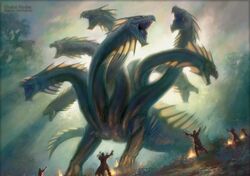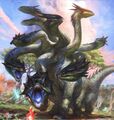Hydra
- For the set codenamed "Hydra", see Conspiracy.
| Hydra | |
|---|---|
| Creature Type | |
| (Subtype for creature/kindred cards) | |
| Introduced | Alpha |
| Last used | Iconic species |
| Beeble Scale | 1[1] |
| Scryfall Statistics | |
|
70 cards | |
|
4 token creation cards | |
|
2 typal cards | |
|
124 artworks | |
Hydra is a mainly green creature type used for cards that depict serpents with many heads, each of which, if cut off, grows back. Hydra heads are mechanically represented by +1/+1 counters, and are known for frequently combining with damage prevention effects to simulate "chopping off the head" from damage.[2] Hydra is the iconic species for the color green.[3][4][5]
Traditionally, Hydras are water serpents, which is reflected in their name (Greek Hudra = water). In Magic they can also be associated with other environments (for example Molten Hydra). The first creature to bear the type was Rock Hydra in Alpha.
Storyline
Alara
Hydras are regarded as the manifestations of the "soul of the world" of Alara, the behemoth Progenitus. Following the Sundering, Hydras were limited to the Shards of Naya and Jund. During the Conflux, new types of Hydras, like the Apocalypse Hydra, appeared that came into conflict with the other Shards, like Bant.
Feral Hydra
Unlike most Hydras, the Feral Hydra lacks any elongated necks. Their features are more feline than those of Hydras found on other planes. Their heads are known to fight among themselves about prey, tearing it apart in the process.
Amonkhet
The hydras of Amonkhet have heads like those of a cobra.[6] Some were captured and treated as pets of the gods, while their wild cousins lived within Ramunap, hiding in the sand to wait to ambush their prey.
Avishkar/Kaladesh
The hydras of Avishkar emit the characteristic blue glow of aether from their throats. Their heads and necks are crested with barbs and bristles. Most hydras have five or six heads, but small hydras with as few as three heads— as well as enormous specimens with eight or more — have been seen in the deep forests far from Ghirapur.
Hydras are fierce predators, favoring prey that has absorbed large quantities of aether from the environment. This taste for aether also leads them to devour aether-powered machines whenever they encounter such devices, from thopters to automatons. In the remote wilderness near Peema where hydras are plentiful, such altercations are rarely an issue. But in the rare event of a hydra coming too close to civilization — or even wandering into one of Ghirapur's greenbelts — they can cause widespread destruction in their hunt for aether.[7]
Dominaria
Unlike most Hydras, Dominarian Hydras are red-aligned, mostly inhabiting mountain ranges and wastelands. Molten Hydras inhabited lava, while the Balduvian Hydra was found in the steppes of Balduvia.
Eldraine
A variety of multi-headed beings inhabit Eldraine, including the famed Questing Beast and Goose Mother. Standard hydras on the plane resemble gigantic multi-headed snapping turtles. Known as snapping hydras, they dwell at the bottom of the Wild's largest lakes or along shorelines where the Wilds meet the ocean.[8] Frequent foes of questing knights, these creatures are aptly named — their bites are known to snap giants' arms cleanly in half. Snapping hydras have naturally long lifespans and strong instincts of self-preservation; when a snapping hydra feels a battle's odds tipping out of its favor, the hydra lets out a raspy screech and retracts into its shell.
Fiora
On Fiora, Hydras are known to have been domesticated by the nobility of Paliano. These hydras are trained to obey their masters command, although they are difficult to train.
Innistrad
Hydras are also found on Innistrad, although they rarely come near civilization. One exemplar with five heads has been observed in the Ulvenwald. Its lamprey-like heads seem to have more in common with Hellions than traditional Hydras.
Kamigawa
In Kamigawa: Neon Dynasty, it is revealed that Plant hydras are native to the plane, possibly as a reference to the appearance of the original Yamata no Orochi of Japanese folklore.
Lorwyn-Shadowmoor
Hydras have been known to appear in The Great Forest of Lorwyn, with specific sightings in Wren's Run. Their gnarled, fibrous bodies are naturally camouflaged and blend seamlessly into roots.
Rath
Rathi Hydras are, like their counterparts on Dominaria, red-aligned. Examples include the four-headed Spitting Hydra.
Ravnica
On Ravnica, three kinds of Hydras have been observed.
Phytohydra
Grown by the Selesnya Conclave. Carnivorous plants with hydra-like regeneration and growth abilities, they can spread at enormous speed and are depicted on cards like Phytohydra and Sprouting Phytohydra.
Simic Hydras
Created by the Simic Combine hydra mutants such as the Hydroid Krasis represent the Simics unique take upon evolution which has resulted in some of the more unique Hydras to exist in the multiverse.
Savageborn Hydra
More traditional Hydras, these entities are part of the Gruul Clans and used to unleash devastation against civilization. Once a hydra chooses a lair and declares the surrounding land its territory, it's almost impossible to drive the creature out. The Gruul revere these multiheaded predators as vestiges of the ancient times before the guilds took over the world. They don't kill hydras for trophies but pulling a spine from a hydra's neck is a mark of great bravery among the Gruul.[9]
Shandalar
Hydras are known to live in the Kalonian Wilds. Like most Hydras, they are massive serpentine creatures with up to six heads.
Tarkir
In the old timeline of Tarkir, Hooded Hydras existed in the forests. These Hydras had strong similarities to cobras and were aligned with the Sultai Brood.
It is not known if any survived in the modern timeline.
Theros
Theran Hydras are very diverse, varying in size and their number of heads. All of them, however, have rapid regenerative properties and acidic blood. They can withstand countless attacks, and some even grow stronger if wounded but not killed. Theran Hydras lay eggs, with one of the parents hatching them. Newly hatched Hydras are already bicephalic.
Hydras can spend years dormant, but they continue to grow during this time. Great thickets grow over the largest sleeping hydras, hiding them from wanderers. When they awaken, they go on rampages that destroy great swaths of land.[10]
Zendikar
Hydras are among the fauna of Zendikar. Relatively small hydras, such as those found in Tazeem’s Vastwood, have only five heads, but the largest hydras in Ora Ondar have eight. A hydra's heads come together on long, thin necks, connecting to a four-legged body with wide shoulders and narrow hips. Frilled crests adorn its heads and upper necks, and run down the creature's long tail. For all their great bulk, hydras can move quickly and with surprising agility through their forest homes.[11]
Some elvish tribes are known to have made alliances with hydras, like the Khalni Hydra, to protect them in times of need.
Hydra Heads
Head is a creature type that was used in the Face the Hydra Challenge Deck
Notable Hydras
- Unknown
Tokens
| Token name | Color | Type line | P/T | Text box | Source | Printings |
|---|---|---|---|---|---|---|
| Hydra | Creature — Hydra | 0/0 | ||||
| Creature — Hydra | X/X | |||||
| Creature — Hydra | X/X | |||||
| Sprouting Phytohydra | Creature — Plant Hydra | 0/2 | Defender Whenever Sprouting Phytohydra is dealt damage, you may put a token that's a copy of Sprouting Phytohydra onto the battlefield. |
|||
| Honored Hydra | Creature — Zombie Snake Hydra | 6/6 | Trample | |||
| Phyrexian Hydra | Creature — Phyrexian Hydra | 3/3 | Reach | |||
| Creature — Phyrexian Hydra | 3/3 | Lifelink |
- Sprouting Phytohydra produces tokens that are copies of the card itself.
Manland
- Lair of the Hydra can become an X/X
Hydra creature.
Trivia
- Ulasht, the Hate Seed is a Hellion-Headed Hydra.[12] The Hellion type was added later.
- Phyrexian Hydra is a Hellion-Headed Hydra, as well. The Hellion type isn't added, yet, but the Phyrexian type has.
- Feral Hydra is a Hydra Beast.
- Genesis Hydra, Phytohydra, Sprouting Phytohydra and Briar Hydra are Plant Hydras.
- Hydras were previously a Red type, with five cards printed in mono-red up until Nemesis's Ancient Hydra. Clockwork Hydra is the only Artifact and colorless Hydra. After Time Spiral, however, no other nongreen Hydras were printed until the mono-red Shivan Devastator (Dominaria United) in Dominaria United.
- Progenitus gives Hydras a five-color representative, but putting that aside, white has only one other (Phytohydra) while blue and black have four others.
- Nyxborn Hydra is the first common Hydra in Modern Horizons 3. Multi-Headed, an acorn card, merely grafted the Hydra type onto another creature; incidentally, Nyxborn Hydra has bestow, in a way also grafting "hydra-ness" to a creature.
- Aspect of Hydra is an instant that pumps a creature according to its controller's devotion to green.
- Hydra's Growth is an Aura that grows a creature by doubling the number of +1/+1 counters on it.
Gallery
-
A Beast Hydra from Alara.
-
Progenitus, Avatar Hydra, the Soul of Alara.
-
A Snake Hydra embalmed (Zombie) from Amonkhet.
-
A Molten Hydra from Dominaria.
-
An Artifact Hydra from Dominaria.
-
A Domesticated Hydra from Fiora.
-
A Lizard Hydra from Ikoria.
-
Phyrexian Hydra from New Phyrexia.
-
Rath.
-
A Jellyfish Hydra Beast, Simic Krasis (Ravnica).
-
A Phytohydra (plant hydra) from Ravnica.
-
Kalonian Hydra from Shandalar.
-
A Snake Hydra from Tarkir.
-
A Mistcutter Hydra, so far the one with the most heads. Theros.
-
Polukranos, a Zombie Hydra from The Underworld of Theros.
-
Capricopian, a Goat Hydra (probably from Ikoria).
-
Genesis Hydra, a Plant Hydra.
-
Compleated New Phyrexian Hydra concept.
References
- ↑ Mark Rosewater (October 22, 2018). "Are the iconic/characteristic races considered a 1 on the Beeble Scale?". Blogatog. Tumblr.
- ↑ Doug Beyer (July 01, 2009). "X+1 Heads Are Better Than X". magicthegathering.com. Wizards of the Coast. Archived from the original on 2020-10-22.
- ↑ Doug Beyer (January 12, 2011). "Season Seventeen". magicthegathering.com. Wizards of the Coast. Archived from the original on 2021-04-17.
- ↑ Mark Rosewater (March 20, 2012). "Most of the colors have their marquee creatures". Blogatog. Tumblr.
- ↑ Mark Rosewater (March 15, 2015). "Characteristic and iconic creatures for each color?". Blogatog. Tumblr.
- ↑ Plane Shift: Amonkhet
- ↑ Plane Shift - Kaladesh
- ↑ James Wyatt et al. (2023). "D&D Monstrous Compendium: Vol. 4: Eldraine Creatures". Wizards of the Coast.
- ↑ D&D Guildmasters' Guide to Ravnica
- ↑ The Magic Creative Team (September 04, 2013). "Planeswalker's Guide to Theros, Part 3". magicthegathering.com. Wizards of the Coast.
- ↑ Plane Shift: Zendikar
- ↑ Magic Arcana (January 09, 2006). "The Hellion-Headed Hydra". magicthegathering.com. Wizards of the Coast. Archived from the original on 2020-10-20.

































